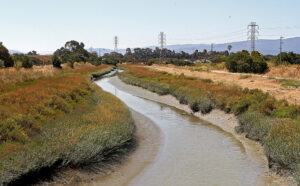This is the kind of morning I dream of. A fantastic new Ben Goldfarb interview about beaver magic AND a great local article about beaver sighting in Palo Alto with a great discussion of our historic papers with Rick Lanman, I just have to try and share both.
Take time to listen to the whole piece. It even praises Martinez!
The beaver is back: Pair of the semiaquatic rodents spotted in Palo Alto
More than 160 years ago, the sight and sound of beavers in local creeks was likely common, splashing their paddle-like tails with their brown bodies gliding through the water with noses just above the water line.
But now, the beaver is back. In April, the first beaver was spotted in a remote stretch of Matadero Creek. Today, there are two of the chubby herbivores. If they successfully reinhabit local creeks, the presence of these large, semiaquatic rodents could herald a return of other long-disappeared species, including salmon, endangered amphibiasemins and birds, according to scientists.
The beavers might also play crucial roles in recharging groundwater, repairing stream-channel erosion and restoring wetlands, said Dr. Rick Lanman, a Los Altos-based physician scientist, historical ecologist and president of the Institute of Historical Ecology.
For Lanman, whose groundbreaking work found that beavers were native to Santa Clara County, the journey to rediscover beavers began in 1987. His Los Altos home is located near Adobe Creek.
Oh goodness, Hi Rick! Great t0 see you back in the papers, I’ll share just one more quote and then you have to go read the whole thing yourself.
 Nine years after Lanman and the Institute of Historical Ecology published their findings, in April, Palo Alto resident Bill Leikam, co-founder and board president of the Urban Wildlife Research Project, documented the first modern evidence of beavers in a remote section of Matadero Creek. Leikam, who is known for his research on the celebrated baylands gray foxes, captured images of a beaver on trail cameras after being alerted by a friend. First one, and then two beavers appeared in the ghostly black-and-white images.
Nine years after Lanman and the Institute of Historical Ecology published their findings, in April, Palo Alto resident Bill Leikam, co-founder and board president of the Urban Wildlife Research Project, documented the first modern evidence of beavers in a remote section of Matadero Creek. Leikam, who is known for his research on the celebrated baylands gray foxes, captured images of a beaver on trail cameras after being alerted by a friend. First one, and then two beavers appeared in the ghostly black-and-white images.
The two beavers spotted this year in Palo Alto, if a compatible pair, could potentially mate and start a colony of little beavers with the potential to inhabit San Francisquito Creek and move into adjacent San Mateo County. At a certain point, in favorable habitat and with an open corridor, the population could jump, Lanman said.
“It’s gonna get real interesting. When they reach there, they’ll be able to come upstream, and that’s a big system. And it’s important because beaver provide important ecosystem services. Beaver ponds are insect cafeterias for coho salmon fry. Survival increases like 200 times when there’s a beaver pond for them. It’s a sheltered place filled with bugs,” he said, and provides shelter for steelhead trout and for Chinook salmon.
Beaver footholds across the landscape are making a huge difference. And creating a kind of scaffolding that allows support for the next beaver step across the landscape. We are building as we go.
In the city of Martinez, beavers colonized Alhambra Creek and turned the waterway from a trickle to multiple rich ponds and dams. The creek now hosts steelhead trout, and river otter, mink, green heron, hooded mergansers and tule perch, a species of fish likely not previously seen in Alhambra Creek, according to the website martinezbeavers.org.
Lanman and Leikam hope the Palo Alto beavers will also usher in an enriched ecosystem.
“It’s so exciting for me to see. Ten years later after we published these papers, finally they show up a couple of miles from my house,” Lanman said.



 The 17 foxes belonging to four skulks, or groups, that Leikam has studied as a retirement hobby and given names like Dark, Sideburns and One-Eye, have gone missing or turned up dead in the last month, victims, he believes, of a fast-spreading disease.
The 17 foxes belonging to four skulks, or groups, that Leikam has studied as a retirement hobby and given names like Dark, Sideburns and One-Eye, have gone missing or turned up dead in the last month, victims, he believes, of a fast-spreading disease. Dr. Deana Clifford, a lead veterinarian with Fish and Game and researcher at UC Davis, said that such numbers are “unfortunately very typical of a localized outbreak” and that the virus can “dramatically reduce the number of animals in an area and even make it seem like they’ve disappeared altogether for a while.”
Dr. Deana Clifford, a lead veterinarian with Fish and Game and researcher at UC Davis, said that such numbers are “unfortunately very typical of a localized outbreak” and that the virus can “dramatically reduce the number of animals in an area and even make it seem like they’ve disappeared altogether for a while.”



































